We have previously talked about personality preferences and how different personality types might come to coaching. In this article, we are sharing some thoughts on the personalities of the doctors that come to our courses, and the challenges they face, maybe as a result of their personality differences.
We’ve trained over two hundred and fifty doctors now. We only have very small groups on our courses, a maximum of nine. As a result, we get to know our doctors really well and we know how they work in the coaching space. One of the things that we’ve noticed that’s not necessarily related to personality but related to their role as doctors and their training as doctors is the lack of space in their coaching. They tend to move very quickly in asking questions, they tend to ask a lot of closed questions, and they don’t leave a lot of silence. By the end of our coaching training, there’s much more space in the conversations they’re having. This is all very
Not All Our Doctors Are GPs
We are also joined by other medical professionals including anaesthetists, surgeons, psychiatrists, paediatricians, all sorts of different doctors, and a dentist.
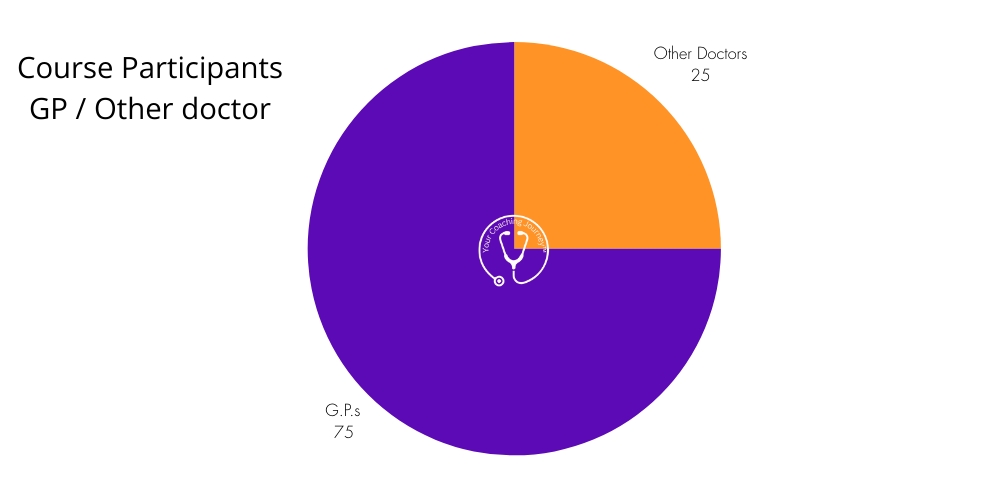
We came across some research by a U.K. doctor, that was done in 2016, about how doctors interrupt and they don’t give people time to speak. He came to the conclusion that it was about 38 seconds that doctors would allow the patient to talk before they interrupted.
In coaching we like the space to allow people to think and speak, so we’re not going to interrupt people, we’re going to let them talk and they could talk for half an hour, really, if it’s useful. And we might have what seem like long periods of silence while someone is thinking. And so for our coaching doctors, that’s one thing that we’ve noticed, by the end of the six months they’re leaving that lovely long stretch of silence and just relaxing into it allowing the emergent conversation to flow.
There is a huge gender difference in our coaching doctors community with 91% being female. We, of course, welcome men to the programme and are seeing more coming through this year than previously.
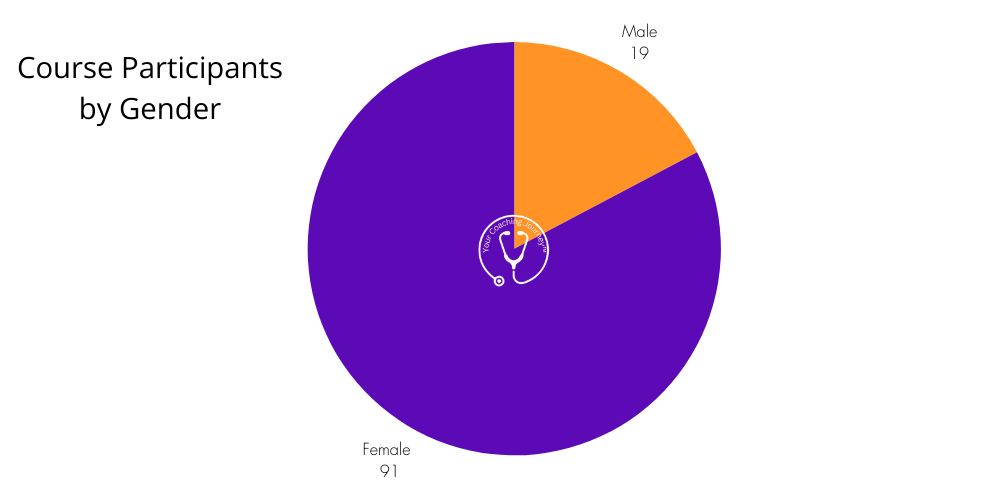
In episode 78 of our podcast, we looked at personality preferences, and the whole idea of personality profiling. And over the last five years of running our program, a lot of the doctors that have come to us have completed a personality profile. So we have their MBTI letters. In talking about the personality profiles of those that come to our course, we can look at some of the challenges that arise, maybe because they have that personality profile. Here’s what we’ve discovered.
Introverts or Extroverts?
What we’ve noticed is that people get a bit concerned about being quite quiet and introverted, and they worry that that is going to impede them as a coach. We often reassure them that, you know, we don’t want them to be talking all the time like an extrovert might. We do think that introversion lends itself to the coaching room a little bit more.
If you’re wondering how extroverts can ever leave space in their coaching, we’re extroverts, and we do talk a lot, don’t worry, we’re trained out of it.
What percentage of the people on our courses that have done the MBTI profile are introverts?
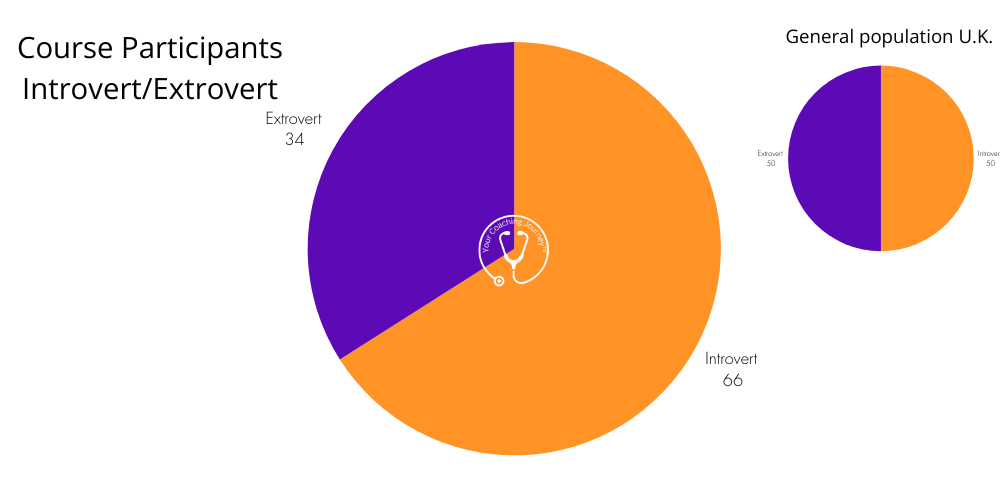
This data is based on MBTI profiling and the company that run it, their data is that the general population is roughly 50, 50 split of introverts and extroverts in the UK.
Coaching is an introverted activity, so we think you have a bit of a head start when it comes to learning to coach. Introverts probably struggle less than the extroverts in terms of not jumping in, not talking over someone, not interrupting them, and just holding that space while people talk. Because they’re used to that way being.
They will also more readily understanding, if they’re coaching an introvert, about how the coachee might think by going into their head before they speak. Whereas us extroverts just talk things through. However, if you’re an extrovert looking at the course, don’t panic, it’s just an interesting difference but, as we’ve said, we’re extroverts, and a third of our alumni are, so you’re in good hands.
A recent extrovert graduate with us told us in the last month how lovely it was that they’ve learned to give people space to think and talk space because it’s changed their relationship dynamics and their ability to have conversations within their family. Rather than doing all the talking, they are now really listening to other people’s issues and problems and able to see things from different perspectives. We often hear how there’s much less inclination to give advice when you’ve learned to coach. You hold that space, you listen and ask some questions, but don’t rush to tell people what to do.
Introverts Aren’t Always Fans of Groups
On our courses individuals are coming together in a group, but it’s a small group with a maximum of nine people. We ease them in gently, they all get to know each other and that’s good for introverts. And then they work in small groups in breakout rooms. Again, its’s really good for introverts to be in small group settings.
Often introverts retreat in bigger groups as the extroverts speak up more, however, we are both expert facilitators, so we make sure that in our training, everyone has the time and the space to have their voice heard.
What Other Personality Traits Have We Explored?
In MBTI profiling, the next element is the Sensing – Intuition preference. Sensing people tend to focus on detailed practical applications of things. They drill down into what’s real. They like to be able to touch things.
The opposite of that is intuition: big picture, concepts, ideas, theories, not really needing to know how it’s going to work, but just quite liking the idea.
- Within the general population around 75% are more sensing (practical) and 25% are more on the intuition side.
- In our coaching doctors it’s a 50:50 split
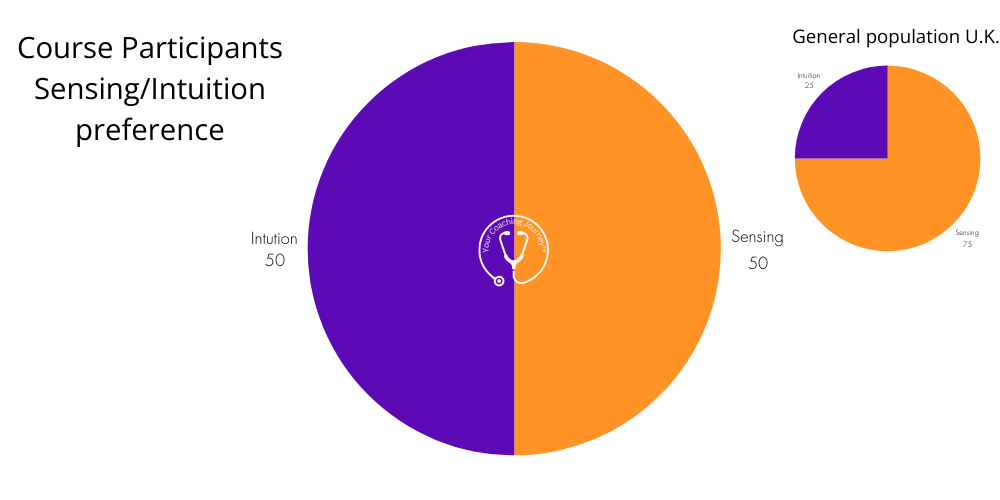
In the coaching room, we want our coachees to come up with new ideas; in some ways getting unstuck requires a bit of imagination, a bit of free thinking, which are all kind of intuition based concepts. If as a coach you’re more matter of fact, more process driven, more, ‘how’s it going to work?’ that could lead to you moving on to the detail more quickly, and restricting your coachee’s thinking in some way.
The detail can be useful with more goal focused work when we’re looking at how are client’s are going to do the next step and making detailed plan.
That intuition preference does serve people well. When you’re having those conversations you’re trying to expand people’s awareness, give them more room to allow them to come up with their own ideas, and we want to hear their story. When we’re listening to their story, we want to pick up on the general thread of the story, pick up the themes but we’re not drilling down into the detail. We don’t want to know ‘when did that happen’ and ‘what did they say’, or ‘what happened next?’. We want them to tell their story, but we then want to move them on and take some of the themes with us.
So we’ll summarise, but we’re not going to be drilling down into the detail. People with an intuition preference perhaps find that bit easier. And maybe some of the challenge for the people with a sensing preference, if they are very practical and task focused, might be to step back a little and hold that space and not move on to the planning too soon. We now work quite a bit with doctors interested in lifestyle medicine where they’re definitely going to be doing some planning with their clients, for example, if someone wants to lose weight, they’re going to have a plan, and they’re going to want to check in with a plan. But that initial piece around what’s this all about and who do you want to be? is extremely important, and we don’t want to rush it. That’s perhaps more tricky for someone with a sensing preference.
People with an intuition of preference might struggle more with the planning phase. But all of that is a learning process and rest assured you can relax into it all in time as you develop your skills as a coach.
Thinking Personality versus Feeling Personality
People with a thinking preference tend to be analytical, logical, they make decisions based on the facts.
People with a feeling preference tend to be much more empathetic, they make decisions based on their feelings, their gut feeling, their values how other people might feel about it.
Quite often the shorthand is that ‘thinking’ people are very task focused and ‘feeling’ people are very people focused.
The population split is roughly 50, 50 but in our coaching doctors, 90% of them have a feeling preference.
We were very surprised by this and wondered if it was just a doctor thing, but actually 36% of medical students have a feeling preference (based on some research done some time ago).
Interestingly, of the 10% who were ‘thinking’, almost all of them were very close to the middle of the spectrum, verging on having a feeling preference.
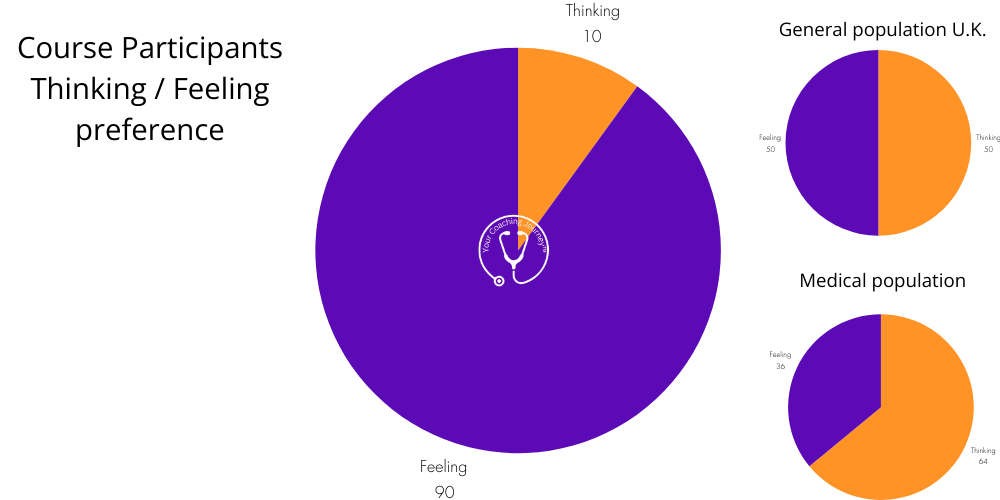
So we see our coaching doctors are bucking the trend because typically more people with a thinking preference come to medicine and then we’ve got far more medical professionals with a feeling preference coming to coaching.
Tom was talking to Dr Jo Hartley, one of our alumni about this phenomenon when she was on the course and saying that he was expecting more to be analytical because of the need to analyse and diagnose. And she said, “yes, but Tom, we’re kind of self selecting. We’ve come to coaching because we like people and we like talking to people and we have that empathy. We’re the empathetic doctors.” (You can listen to us chatting with Jo here.)
What Do These Aspects of Personality Present As A Challenge?
In terms of the 90% who are ‘feeling’ people, that’s great because they’re empathetic, they want to sit and listen to people. They are happy with people expressing their emotions. There is possibly a danger of over empathising and becoming emotionally attached in some way. On the course we talk different forms of empathy and how it is important to keep the boundaries in place to ensure that we aren’t attached to the outcome. It is entirely possible to work on this, to calm your emotionally empathetic side and to learn to listen and help people without becoming so emotionally involved.
Those with a thinking preference probably easier to be objective and to step back and actually look at things rationally, to analyse them and maybe help someone work through something that perhaps is emotional, and ask good questions that will allow someone to explore it in a more rational way.
The Judging – Perceiving Spectrum
The last dimension that we look at is judging and perceiving. This is the difference between how people organise their life.
People with a judging preference like to be organised, they like to be planful, and they like to work the plan. They get annoyed if other people don’t work the plan. They like things to be finished before they move on.
People with a perceiving preference are much more ‘go with the flow’ people, they will do lots of different things at the same time. They like a bit of variety. They don’t like to be pinned down to a plan. They are very last minute.
In terms of the UK general population spread, it’s roughly 2/3 have a judging preference., so they’re more on the planful side.
In terms of our doctors, it was about the same, 70% of them have a judging preference. They’re very organised. 30% less so, and much more spontaneous.
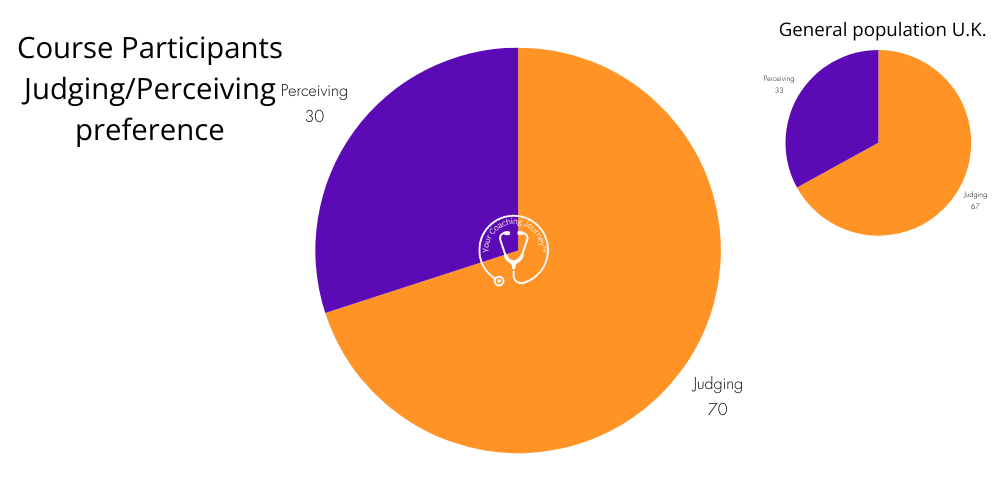
Being a perceiving type of person can be a challenge. I think if you are looking to put coaching into your portfolio or work in the coaching industry and like us, and you are a little bit last minute, or not quite so planful, you do have to be aware of that and to make sure you show up without that last minute rush. We need to have a calm, centred presence in the coaching room, virtual or otherwise.
If you’ve got the opposite preference of the person you’re coaching, sometimes that can be a challenge. So if I’m coaching someone who’s very process driven, likes the plan, likes kind of wants it all planned out, um, that’s more difficult for me to work with than someone that’s more spontaneous. But I can do it. It’s just more difficult and I think the same, probably worse the other way around. So if you’ve got someone with a very strong judging preference and then someone with the perceiving preference that they’re trying to coach and they’ve got a plan of what they’re going to do for the next three months and they don’t stick to the plan, I think that the coach would be thinking, well, hang on, we agree this, we have a plan. Why are you not working the plan? Uh, but because if someone has a perceiving preference, they are going to be all over the place. They’re going to be not following the plan at all.
Helen Leathers: And I think coming to coaching, if you have that judging preference, I would imagine that they are uh, the people coming to coaching saying, what do I do? I want a formula to follow, I want an exact process to follow with clients. And obviously we have a framework for coaching which lends itself to that. But there is a requirement to be a little bit flexible with that, a little bit emergent and to have a little bit of flow.
Tom Dillon: You need to be agile.
Helen Leathers: That’s the worst.
Tom Dillon: So the TOMS code framework follows a path through the coaching and you could just stick to the path. Yes, but actually life is more complex to that and coaching conversations are more complex and they don’t always start at the beginning. So you have to have that bit of agility. But I think it’s useful for those with uh, that judging process way
Tom Dillon: of being to have that process to follow to start with and then they can go off script later on. But I think it is useful to have the framework.
Helen Leathers: Yeah.
Tom Dillon: And for people with a perceiving preference, they probably just leave the framework a lot earlier. You go, oh, I didn’t stick to the script. Which is absolutely fine. But, uh, but maybe sometimes, you know, at the beginning of our coaching sessions we always get people to do a little bit of contract in terms of, okay, we’ve got 20 minutes, what would you like to talk about? And then what would you like by the end of it? And how important is, is it for you to have that now if we skip all of that and start somewhere else and don’t uh, go back to it, where do we, how do we know where we go with the coaching?
Helen Leathers: Yes.
Tom Dillon: And how do we frame the coaching session? So I think there are elements that are important and they are the bits that someone with a perceiving preference might skip over and go, oh, yeah, I didn’t do that bit.
Helen Leathers: This is really interesting, isn’t it? Yeah, uh, really interesting because it just shows there’s no perfect personality type for a coach or a coaching. And we all need to learn more about ourselves and adjust, uh, the bits that perhaps are less helpful in the coaching room.
The last interesting fact about the coaching doctors that come to us is the overall type. When you do an MBTI profile, you end up with four letters. We’re both ENFP; extroverted intuition based (N for intuition because we use the I For introversion), feeling and perceiving.
Of the doctors that come to our coaching training, 30% of them have the type INFJ. Introverts, with an intuition, (that’s big picture), feeling (people-focussed), and planning preferences.
In terms of the UK general population spread, the biggest percentage in one particular area is 13% and we’ve got 30% in one type. Now if you look at the UK general population spread of that type, it’s only 1.7%.
We’re not trying to say we want that type, or you can’t be any other type, this is just something that’s emerged and we find fascinating.
If you’re wondering whether you would make a good coach, the answer is that anyone can make a good coach. We’ll train you to be a good coach. It’s about understanding yourself but also being open to what you don’t know and developing yourself. And we know that the personal development that comes with this training is huge.
To find out more about our Doctors’ Transformational Coaching Diploma click through here



